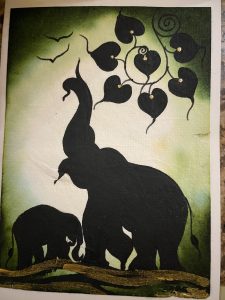Anyone who has visited our home in San Francisco notices many images of Ganesh. He is the deity displayed with an elephant head. Ganesh is considered the remover of obstacles and patron of artists. What I like about him, besides the great symbolism: the whimsical way he is often portrayed. You encounter Ganesh all over Asia, not just in India. In fact, Chiang Mai has some beauties right next to the Buddhist temples.
Elephants themselves feature prominently in Thai culture and imagination. Decades back, traveling to the hill tribes in Northern Thailand was quite popular. Adventurous backpackers would visit them: Akha, Lisu, Lahu and Karen to name a few. These tribes have their own languages and are not necessarily Thai by nationality. Often these three to four day treks would include riding on elephants, through what remains of the jungle.
Over time, people figured out that riding elephants was maybe not such a good idea. Visiting the impoverished hill tribe villages felt sometimes like going to a human zoo. Nowadays trekking has largely disappeared. There is a new fad in the world of mass tourism and Instagram: “Taking care of the elephants.“ No more riding, only feeding and washing the elephants. There are elephant parks, sometimes referred to as sanctuaries, set up for this purpose all over Northern Thailand.
My friend of 31 years, Noo, is in the travel business. We sit down in her office and discuss the present landscape in great detail. Noo is obviously conflicted about it. At some point in the story she becomes visibly teary-eyed. Noo tells me that perhaps in the early morning visitors will feed and bathe the elephants, then take the bus back to their hotel. Soon others arrive, wanting to feed and bathe the elephants all over again. And again.
All the popular camps advertise that the elephants aren’t chained. Technically true, only during the day.
It’s not all black and white however. During Covid for instance there were no tourists, but it became increasingly hard and too expensive to feed the elephants.
A big part of my last visit to the kingdom was getting a new Sak Yant. A Sak Yant is a ritualized tattoo. It is not done at a tattoo parlor, and no tattoo machine is being used. Instead, a metal rod is prodded over and over into the skin by an Arjarn (teacher) or Buddhist monk. It is an elaborate ritual with prayers, intention, chants and incantations. An ancient form of magic. It’s not just about getting the Yant, but also whether you can live up to it. A promise if you will.
Right at the start of Covid I had a small Yant placed on my left back side for general protection. During the last year I communicated with a Sak Yant Arjarn in Hua Hin, a seaside town a couple of hours south of Bangkok. I was intrigued by him and his unique way of making elephant Yants.
An old Belgian friend of mine, Guy Turf, resides in Hua Hin. He is fluent in Thai and proved to be quite helpful. I flew from Chiang Mai to Hua Hin and together we went to see the Arjarn on the outskirts of the city. We talked extensively about elephants as well as the energy of Ganesh. Arjarn Hom explained that Ganesh energy implies strength as well as gentleness.

At last, we started the inking process. At first the poking is slightly irritating. After a while, this took well over four hours, the sensation is far more intense. The pain put me in a trance, part of the offering. I had to remember to keep breathing! Arjarn Hom kept reassuring me how strong I was.
I didn’t realize yet that the suffering was to continue for at least another week. Angry, inflamed skin pulsating against the intense, humid heat. Wandering around in a for me foreign city, that did not always feel entirely agreeable.
Later back in Chiang Mai, my Thai bodyworker and spiritual guide Chai taught me ways to invite this new energy into my system. How to use it in bodywork and life. “Welcome to the club!” he exclaimed jubilantly. Then he proceeded to give me one of the best treatments I’ve ever received. It was more his overall energy, not fancy techniques.
It fascinates me that now that I’ve been back in San Francisco for about a month, I often think of Hua Hin. Especially the light and spacious hotel room I stayed in, while practicing lengthy solitary yoga sessions as I was healing.
On the first day of the new year I decided to give the elephant, as well as myself, a rinse in the ocean! Cindy and I rode our bicycles to Ocean beach. It was a sunny day with hundreds of festive people on the beach, either to watch or participate in the New Year’s plunge. Wooden debris was scattered on the sand from recent storms.
Frankly, the waves were more intimidating than the cold. For the first time I was able to be in the water for several minutes fairly effortlessly. An auspicious start of 2024. I’m looking forward to more stories and our shared yoga practice in the new year!!





Thank you for sharing such a heartwarming story in ‘Elephant Tales’! Your captivating narrative not only entertains but also enlightens, reminding us of the profound connection between humans and animals.